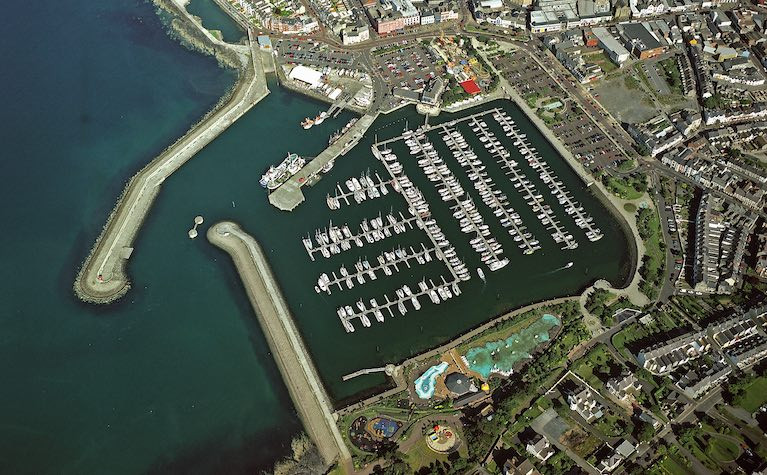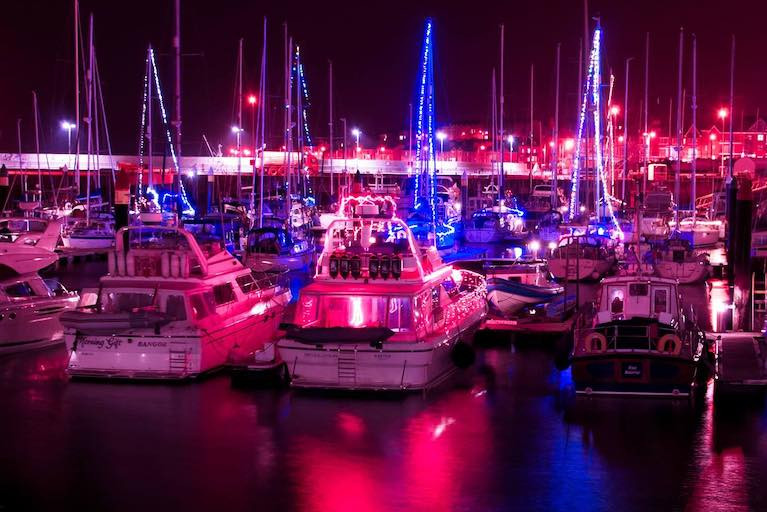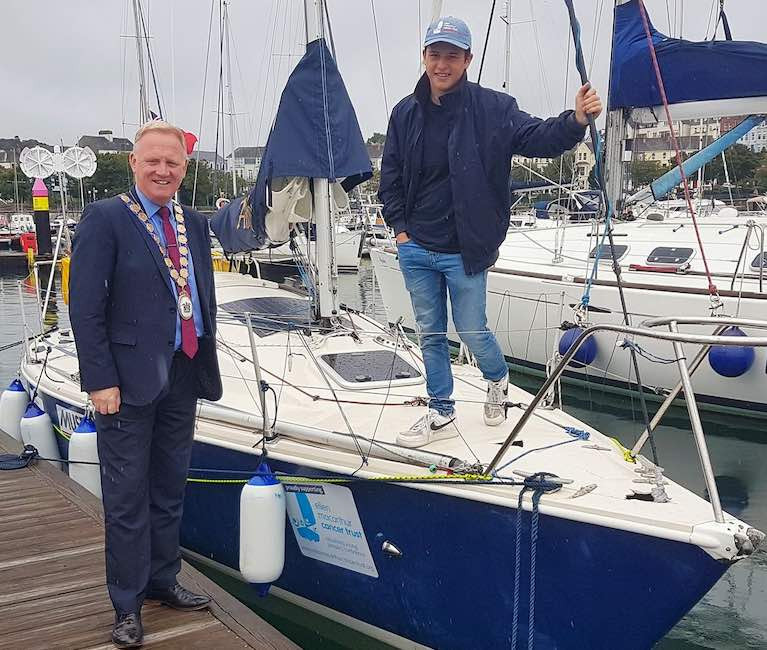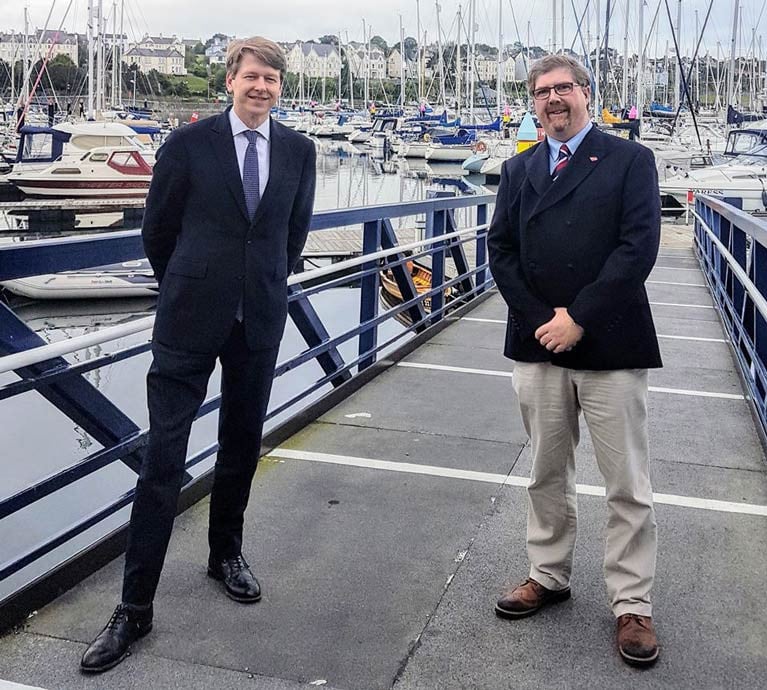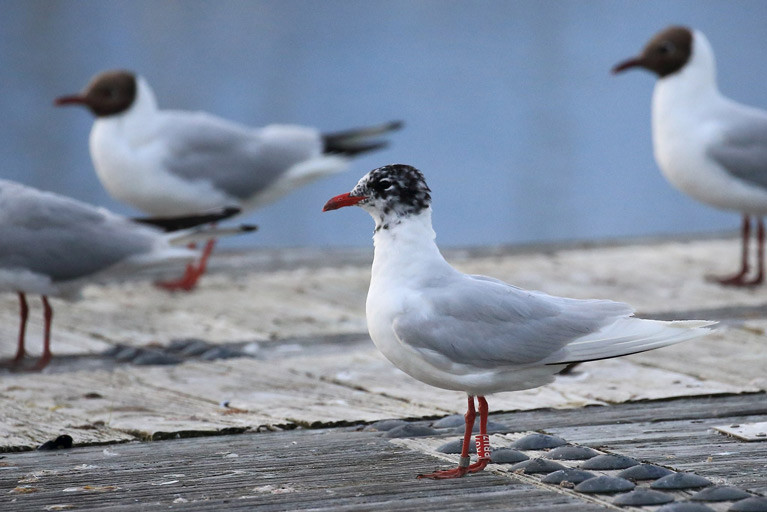Displaying items by tag: Bangor Marina
On a glorious 1st March and after two years of restrictions Bangor Marina on Belfast Lough held their Pancake Tuesday get together again, welcoming a big crowd to a ‘catch up’.
Marina manager Kevin Baird was delighted to see so many berth holders and friends; “ It was wonderful to catch up over a pancake and a cup of tea. Service with a smile - Vickie, Tommy and Davy served up the pancakes. It was a great success”.
The next Marina event will be held on St Patrick's Day - berth holders will be invited to join the staff for Irish Stew and wheaten bread.
Ulster Wildlife Trust to Establish First Native Oyster Nursery on Belfast Lough at Bangor Marina
Did you know that our Native oysters have been an important food source for centuries - the Romans even exported them back to Italy!
The first report of a recognised commercial oyster fishery in Belfast Lough was in 1780 and although the native oyster has been considered extinct there since 1903, in the summer of 2020, live oysters were discovered for the first time in over 100 years – evidence that the environmental conditions for establishment are right.
The charity, Ulster Wildlife Trust, is hoping to establish the first native oyster nursery in Northern Ireland in Bangor Marina on Belfast Lough to support the declining population and to help create a natural long-term carbon store to tackle climate change. So under F, G and H Pontoons, Ulster Wildlife's Heidi McIlvenny with Harbour Master Kevin Baird and his staff will deploy a native oyster nursery.
 Highly prized Loch Ryan Oysters
Highly prized Loch Ryan Oysters
Around 26 cages will be suspended under the pontoon walkways and will be populated with highly prized Loch Ryan Oysters. The Loch Ryan Oyster Bed, one of Scotland’s largest, dates to 1701 when King William 111 granted a Royal Charter to the Wallace family.
The native or flat oyster stays fixed in one place and is a filter feeder meaning it uses its valves to pump water filtering out microscopic algae and small organic particles from the surrounding water. A single oyster can filter up to 200 litres of seawater per day, which can significantly improve water quality and clarity.
Already thriving in another Marina in Conwy Wales, over time the oysters will start releasing oyster larvae into the harbour which will be carried out to settle on the seabed, ultimately resulting in cleaner waters and better marine biodiversity.
Classified as a Priority Species under the UK Post-2010 Biodiversity Framework and a Feature of Conservation Importance for which Marine Conservation Zones can be designated, the oyster has a lifespan of six years.
Harbour Master Kevin Baird would like to get local schools involved after the oysters are in place. “It’s a great environmental project with many very positive benefits”. He added “There will be no disruption to marine traffic”.
Megayacht, superyacht – certainly bigger than any craft in Bangor Marina. Lying alongside the Eisenhower Pier in Bangor Harbour on the North Down coast on a recent visit, after a passage from the Clyde, the 39.62 m motor yacht, Liquid Rehab arrived in Bangor for a brief stopover but stayed longer.
Built in 2004 by Westport Yachts, USA, whose sales office is in Fort Lauderdale in Florida and has two yards in Washington State, this huge three-decked craft cruises at 24 knots and has a top speed of 28 knots. She sleeps 10 and has a crew of seven.
Liquid Rehab is owned by Kevin Martyn, who is in the pharmaceuticals business and has an interest in the USA National Football League. Captain is Jameson Cooper, from North Palm Beach in Florida.
 Vice Commodore Alan Espey, (third right) welcomes Liquid Rehab owner Kevin Martyn (second right) and Captain Jameson Cooper (right) and friends to RUYC
Vice Commodore Alan Espey, (third right) welcomes Liquid Rehab owner Kevin Martyn (second right) and Captain Jameson Cooper (right) and friends to RUYC
Kevin Martyn, Jameson Cooper, members and friends were welcomed to Royal Ulster Yacht Club by Vice Commodore Alan Espey, where they enjoyed lunch in the famous Lipton Room.
Harbour Master Kevin Baird was delighted to welcome Liquid Rehab to Bangor and said on its arrival, " We wish all onboard an enjoyable visit and we trust you will enjoy your stay in Bangor".
Liquid Rehab is currently in Leith near Edinburgh and plans to return to the North Coast of Northern Ireland before calling in Belfast.
The British Government has announced a three-month delay in the implementation of the red diesel ban for private pleasure craft in Northern Ireland.
The move follows lobbying by Bangor Marina and others in the NI leisure boating industry who emphasised the dearth of white diesel options in the region.
Originally set to come into effect on 30 June, the red diesel ban is intended to meet the UK’s obligations under the Northern Ireland Protocol and bring the region in line with the 2018 judgment by the Court of Justice of the European Union.
This is the same ruling which prompted the Republic of Ireland’s ban on green-dyed diesel for leisure craft propulsion last year.
In March, British Chancellor Rishi Sunak announced in his first post-Brexit Budget that boaters in England, Scotland and Wales would continue to use red-dyed diesel for pleasure boating without penalty in domestic waters — leaving NI boaters in limbo.
Bangor Marina says it met earlier this year with officials from HM Revenue & Customs, HM Treasury and RYANI “to discuss the difficulties we would face if we had to switch to white diesel in June.
“During that meeting, we did put forward a compelling proposal that the switch to white diesel should take place after the summer holidays.
“Today [Friday 21 May] we have been advised by HM Revenue & Customs that the UK government has decided to delay the implementation of the prohibition on red diesel used for propulsion of private pleasure boats in NI until 1 October 2021.
“More detailed guidance is expected to be produced in July.”
The decision will come as a relief for cruisers and leisure boaters across Northern Ireland as it emerges from lockdown into the summer boating season.
But with freedom of movement on the cross-border Shannon-Erne Waterway, the extension poses a “customs headache” for Irish authorities, a source close to Afloat.ie suggests.
And if the delay is any indication of a proclivity to continue moving the deadline back, the situation would deal a heavy blow to Irish suppliers, particularly in border areas — while also encouraging boats “to spend more time in NI and less [in the Republic]”, the source added.
Bangor Marina Reopens After Lockdown on Belfast Lough
It isn't an April Fool! Thursday will be to Bangor Marina berth holders the end of a long-awaited return to their craft after a roller coaster of lockdown, opening up and lockdown again over the past year.
In Harbour Master Kevin Baird's welcome email to berth holders yesterday he said "We have spoken with and taken advice from the British Marine Federation, the RYA NI, the UK Harbour Masters Association, as well as consulting with healthcare professionals in order to try and navigate through these extraordinary times". And added, " Last week, Boris Johnson added 'fresh air' to the Coronavirus slogan, as sea-loving folk, we already know that sailing and boating provides that clean, fresh sea air which at this time of the year can blow with considerable strength".
There has been an update to the Regulations (Amendment 6) that outlines aspects from 1st April 2021 - up to 10 people (including children of all ages) from a maximum of two households can take part in outdoor sports activities. He added, "In the reading of these, it would be our understanding that restricted access to the Marina may be permitted".
But the reception, washrooms and laundry will remain closed and overnighting on board is strictly prohibited. The Marina is also closed to visiting craft.
Although reception is closed, staff can be reached by telephone; +44 (0) 28 9145 3297; email [email protected] or VHF Ch 80 or Ch11
Kevin sought to reassure boat owners, "These strange times will not last forever, and the sea will still offer solace when we all need it, and when the time is right".
Green Electricity for Bangor Marina on Belfast Lough
Bangor Marina on Belfast Lough is switching its electricity to a renewable source with immediate effect.
Marina Manager Kevin Baird said the marina takes its responsibility to the environment seriously and is constantly looking at ways in which it can reduce its impact on the planet.
"We estimate this fully renewable supply reduces our carbon emissions by up to 1000 tonnes a year compared with traditional carbon led electricity supplies, which is a massive positive impact", Baird said.
Northern Ireland's biggest marina is part of a network of 11 'boatfolk' operated marinas around the UK all now sourcing fully renewable electricity, and with minimal impact to the price.
The facility at Bangor is a multiple winner of the Blue Flag Award and a Five Gold Anchor Marina. There are facilities for 550 berths with berthing for 50 visiting craft. Laundry, showers, trolleys and local advise provided for sailors.
Baird told Afloat "We're on a journey to reduce our carbon footprint and this is a crucial next step on that journey. 2021 is an important year for the world's efforts to tackle climate change and choosing 100% renewable electricity isn't just a 'feel good' thing to do, it's something that has a very real impact."
'Light Up, Light Up'; Bangor Marina's Call to Boat Owners
Bangor's favourite band, Snow Patrol, are well known for the lines in their hit 'Run' - Light up, Light up. And that's what, in this year of endless restrictions, Kevin Baird Manager of Bangor Marina on Belfast Lough, would like berth holders to do for a competition in December.
It would be especially cheerful in these Covid 19 times, to make an effort, get out your Christmas lights and decorate your boat.
There will be a prize for the best-illuminated craft and equally appealing, is the gift of Mulled Wine for each participant.
Details will be posted on the Marina Facebook page in the coming days and judging will be on the evening of 18th December. Also, keep an eye out for information about another highlight on 18th December.
The usual Mince Pies, Mulled wine, tea, coffee and soft drinks served to you onboard your boat between 2 pm and 5 pm.
Ards & North Down Mayor Welcomes Teen Solo Sailor to Bangor Marina
Mayor of Ards and North Down Councillor Trevor Cummings, visited teen solo sailor Timothy Long onboard his yacht Hunter Impala yacht, Alchemy to welcome him officially to Bangor.
As Afloat reported previously, fifteen-year-old Timothy aims to become the youngest person to sail solo around Britain. Throughout his challenge, Timothy will be fundraising for the Ellen MacArthur Cancer Trust.
He began his voyage south to his home port of Southampton at the weekend.

Timothy's Mum, Sue Elder, who is looking after publicity for his voyage, is full of praise for the welcome he has received. "He has certainly had a wonderful welcome in Bangor! At this rate, he may not want to leave...all of you have been so kind and supportive of him, which means a lot to us as parents, as I'm sure you'll appreciate".
Timothy has been paddleboarding, been treated to lunch, had help with his mast maintenance from another sailor, had dinner on board another boat and been shown round Royal Ulster Yacht Club by Rear Commodore Maurice Butler. Sue Elder adds " Please pass on our heartfelt thanks to the Bangor network for making him so welcome".
Naval Ships & Minister Visit Bangor Marina on Belfast Lough
Bangor Marina on Belfast Lough had high profile visitors last week. Three naval ships, HMS Biter, HMS Charger and HMS Express docked at the marina. All are Archer class patrol and training vessels and attached to Universities in the North West of England. Biter is assigned to Manchester and Salford, Express to Wales University, and Charger to Liverpool University. And a few days before the armed patrol boat HMS Tracker docked in the Harbour.
A few days later the Marina welcomed Minister of State for Northern Ireland Robin Walker.
Ards and North Down Mayor, Councillor Trevor Cummings, Chief Executive Stephen Reid and Director of Regeneration, Development & Planning Susie McCullough, hosted a meeting with the Minister to discuss the opportunities offered by the Belfast Region City Deal and to view the Bangor seafront regeneration programme.
 Three naval ships, HMS Biter, HMS Charger and HMS Express docked at Bangor Marina
Three naval ships, HMS Biter, HMS Charger and HMS Express docked at Bangor Marina
Bangor Marina on Belfast Lough in County Down welcomes visitors from far and wide, but this Mediterranean gull must be one of the most interesting, having travelled from Poland, Spain, and France before flying into Bangor.
Berth holder, wildlife expert and photographer Ronald Surgenor who works for the Ulster Wildlife Nature Reserves team, captured this wonderful photograph of the gull roosting on pontoon B. He was able to trace the bird’s movement via the red numbered ring on its leg. In 2015 the bird was ringed in Poland and over the next five years flew across Europe before flying into Bangor. A truly international visitor!
Ronald says “ Good chance it'll be around the roosting gulls for a while, always worth a quick check on the way past; the white wingtips help pick it out amongst the Black-headed gulls and their dark wingtips. I always carry the camera on the boat as you never know what you will see out on the water”.
As previously portrayed in Afloat.ie on 5th June, Bangor Harbour is a valuable haven for wildlife.


























